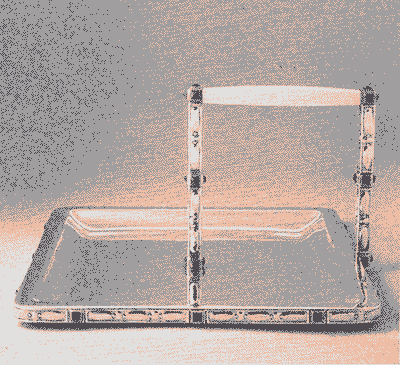I]
Vienna, City of Dreams. Carnegie Hall, Austrian Cultural Forum, Center for Architecture, Frick Art Reference Library, Jewish Museum, Juilliard School, Keyes Art Projects, (Le) Poisson Rouge, Leo Baeck Institute, The Morgan Library & Museum, Museum of Modern Art, Neue Galerie, New York Public Library, Paley Center for Media, Viennese Opera Ball in New York, February 21—March 16, 2014.
VIENNA LITE! A bit of decadence, a strain of waltz, a touch of Schönberg, Mahler, Klimt. Freud may be mentioned, but not discussed. And it's coming to a concert hall, a gallery or a library near you, if you live in New York City. History, once again, will be defined by the sponsors of the "City of Dreams" Festival: by the Andrew W. Mellon Foundation, a propaganda wing of the CP [Capitalist Party]. As we are told in the program notes for Carnegie Hall, "Schoenberg, Berg, Webern, and their compatriots sought to reorganize musical material into a hierarchy that reflected a new age."
What hierarchy is that? What age? The mature twelve-tone system, the major achievements
of Freudian psychoanalysis, of Wittgenstein's philosophy, of the novelist Robert Musil, the economist Karl Polanyi, the early development of Adorno's thought and the Frankfurt School occurred, not in the twilight of the Habsburg Dynasty but in the period of "Red Vienna," 1919-1934, under the supportive rule of the Austro-Marxist government. Webern led a worker's chorus in the 'twenties, and Berg's Wozzeck is probably the least hierarchical opera ever written. The order proposed for this festival is, as Adorno put it, the natural order, a form of musical class system, in which the secondary degrees submit as willingly to the tonic and dominant as workers and private businessmen yield to authoritarian state syndicates in the fascist state. The Mellon Foundation has every reason to collude in the suppression of these facts since Mellon himself, as Secretary of the Treasury at the outbreak of the Great Depression, was an enthusiastic proponent of the policies and attitudes that led to the destruction of Red Vienna by the Austro-Fascists in alliance with Big Business. The Mellon Foundation carries on the family tradition: The publicity trailer for the Carnegie Hall events combines a Burkean denunciation of the French Revolution with a Whiggish endorsement of the Habsburg Dynasty: "[Austria] did not have the French Revolution. Vienna embodied both Enlightenment but also stability." Stability? Avoiding revolution? You're sheissing me.
Wie auch die Lüge uns schmähend umkreist, alles besiegend erhebt sich der Geist. From here until March, 2014, WOID will be doing its best to ensure that the radical side of Viennese Culture is fairly represented in the galleries, the classrooms, the concert halls of New York City. Keep me posted if you're planning any courses, lectures, or banner-bearing marches. Herrn der Fabriken, ihr Herren der Welt, endlich wird eure Herrschaft gefällt.
II]
The Vienna Model. Housing for the 21st Century City.
Austrian Cultural Forum - New York, April 17 through September 2, 2013. (Subsequently in Los Angeles, San Francisco and Washington, DC.)"The international acclaim that Viennese low-cost housing of this period received when new seems rather exaggerated now. From the first its significance was more political than architectural." - MoMAman Henry-Russell Hitchcock, the man who did for American architecture what Beaumont Newhall did for Photography. Both of them worked for MoMA in the 'thirties, both of them ensured that "Modernism" would be purged of any political reference—or rather, any incorrect political reference: After all, the cold-hearted efficiency that passes for "Modernism" in Hitchcock's book is a political value, too, since it defines relationships among producers. And we all know the type of producers for whom "efficiency" and "economies of scale" are positive values.
Every ten years or so the Austrian Cultural Forum, the propaganda arm of the Austrian Government and I say that in a good way, decides to put on a show about architecture. The show that opened this past Tuesday was about public housing. The public housing program of Red Vienna was one its great successes, but the show itself is a bit bland, glossy videos of happy children and all that. The more recent buildings displayed seem a bit too formal; too much of a compromise with efficiency and economies of scale.
At least the panel discussion that opened this exhibition was refreshingly political: the Huffington Post had run an enthusiastic article drawing attention to the radical aspects of the Viennese architectural tradition, drawing in the New York activists. It was the usual handwringing "what are we gonna do?" from Bloomberg's representative on the panel, and the usual "Everything's gemütlich" from the Austrians. And, yes, it is nice to hear that sixty percent of the population of Vienna lives in subsidized housing; that the City of Vienna retains the land, even when construction is turned over to private developers who in any case are often companies funded and run by trade unions. But when I asked about the relationship between Vienna's City Government and the investment banks I got a slightly panicked response: in the present neo-liberal climate in Europe where access to capital is increasingly restricted, the forces of international finance seem as willing to destabilize the Viennese Model as the Mellons and Rockefellers were, and are, to delegitimize the cultural contributions of Red Vienna. Perhaps it's time to rethink the contributions of the Austrian-born economist Rudolf Hilferding, a Marxist who argued that it was possible to reach accommodation between socialist government and finance capital. As we say back in Vienna, Mit ein tuchas ken me nit tantzn bai tzvei chasanes.
Vienna, City of Dreams is sponsored by the Andrew W. Mellon Foundation; Vienna, City of Red Utopias is sponsored by the Giddiyap Society.
[4/21/2013]
III]
Koloman Moser. Designing Modern Vienna 1897-1907. Neue Galerie New York, May 23 through September 2, 2013; Museum of Fine Arts, Houston, September 29, 2013-January 12, 2014. Curated by Christian Witt-Döring.
This has to be some kind of a first, or something I don't remember seeing in a long, long time: a show that talks of Vienna, pre-World War I, in terms of Modernism, not modernity; in terms, not of Fin-de-Siècle decadence, but of Début-de-Siècle progress. Koloman Moser was one of those gifted artists at the center of Viennese literary and cultural life, a founder of the Vienna Secession and the Wiener Werkstätte. The first room in this show displays him in all of his Jugendstil flamboyance, along with a model of the "Golden Cabbage" exhibition hall which he helped to design.
You can skip that room. What we witness in the rest of this rich, unobtrusively but elegantly designed exhibition (with occasional mismatched labels, incidentally), is Moser's movement away from the ornate and the organic and toward something Kenneth Frampton calls the "classicizing post-Secession:" lines become simpler and shapes more geometric, putting Moser on a par with the young Corbusier. Halfway through the show the showy part, the "decadence" conveyed through silver, intarsia or other luxury materials, takes second place to the simplified form of the object.
Moser, who after all designed these objects as opposed to executing them, is taking up contemporary arguments for the typus, the object as a prototype, an idea that was to reach its full fruition in the Bauhaus. The marbled papers on display are like nothing seen before or since, because the execution of a marbled paper depends on repeating a series of simple movements without quite getting the same effect each time: the typus as gesture. In their pure, formal confidence these papers look forward to Robert Motherwell's own use of the typus in the Elegy series. But the triumph in this show is an elegant sideboard edged in blue, designed in 1905 for a wealthy Berlin family but executed in pinewood, the cheapest material available. It looks forward to the efficiency kitchens that Margarete Schütte-Lihotzky was to design for workers' housing projects in the early 'twenties. Many of the objects are at once functional in design and practical in application, like a table for the shop run by Emilie Flöge and her sisters, along with the sign for the shop itself. The design for a dress reminds us that the new movement for simplicity circa 1905 was aimed at liberating bodies as well as forms. For those of us who've labored against all academic and popular clichés to draw out the continuum between the Vienna of 1900 and the "Red Vienna" of the nineteen-twenties, it's like having a huge load off our shoulders: And finally the tables are starting to turn. [Talking about tables...]
[5/23/2013]
IV]
Austria: Coming to Terms with a Troubled History. Thursday, February 27 at 5:30 pm at The Paley Center for Media, New York. Sponsored by the Chumir Foundation for Ethics in Leadership.
It's called Pulling a Weimar: As the copy for the panel discussion "Coming to Terms" announces, "Vienna's creative, cultured, and open society deteriorated in the years leading to the 1938 Anschluss... Why did it happen?" Well, folks, for starters you might want to check out the standard history of the interwar period, written by someone who had actually interviewed the people responsible. And guess what? it wasn't "liberal democracy," it was a fascist takeover sponsored, as in Germany, by big business and its apologists. Yes, folks: it was Beast killed the Beauty. So now can we move on?
Vienna Complex. Austrian Cultural Forum, New York, February 27-May 25, 2014.
"The exhibition features contemporary artistic reflections on the phenonemon of our modern meritocracy." Meaning a handful of privileged artistes are going to "express themselves" on the elitism of those bourgeois psychoanalysts. So now can we move on?
[3/3/2014]
David Grimm. Tales from Red Vienna. City Center Stage, New York, through April 20.
Good thing I never actually watched this one, they would have thrown me out for Laughter Unbecoming. What Puccini's Tosca is to the Roman Republic, Grimm's tale is to Red Vienna: the Well-Made Play in the tradition of Victorien Sardou, a "historical" play in which everything's brought down to what the French delicately call des histoires de cul. The play is set in the period immediately following World War One, a time when the newly ruined and others were camping out in the Vienna Woods or in disaffected army baracks and eating at free kitchens, and no doubt would have been glad to sell their bods if there'd been any takers; it's not so much that it's anachronistic in the detail, but in its sentimental purpose, which, in the tradition of the Well-Made Play, is to turn sordid domestic interactions (of the kind Maupassant and Schnitzler handled so well) into grand tragedies. In this case the Noble Heroine is a "Noble Widow," meaning the widow of a nobleman, and said NW must sell the sweet treasure of her virtue to, of all things, a Socialist. (This will make widows wince. But fictive things / Wink as they will. Wink most when widows wince. ) Apparently the author hasn't read the memo: socialists practice Free Love, it's the bourgies that pay for it. He's read plenty of other memos, though, so the play's liberally sprinkled with references to Weltschmerz, anti-semitism, etc. Its anachronism is not so much a leap backward but forward, not inaccurate but reactionary, a leap into “images of false resurrection one finds everywhere: long dresses and military comedies, images of naïve neutrality... the march into the nineteenth century, ” as Adorno wrote. If you need to cleanse your palate after this I would recommend Josef Roth's novel of post-war loss and sexuality, Flight Without End. And now let's move on...
[3/19/2014; last revised 6/20/2016]
- Paul Werner


